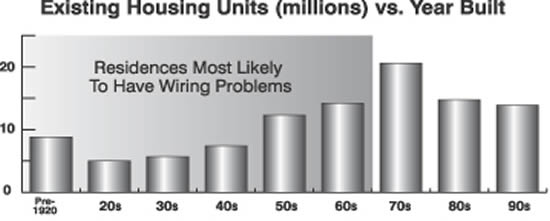May 2002
What to Do about Aging Electrical Wiring
Like antique furniture, older homes offer wonderful decorative details and craftsmanship. But, unfortunately, building materials don't last forever. Electrical wiring, especially in old homes, can pose a serious hazard if not replaced. More than 60 million U.S. homes and apartment units were built before 1975. Many are candidates for new electrical wiring.

In many ways, the 20th century was a time of experimentation with electrical wiring practices. A few old-timers today may remember push-button light switches. When the on-button was pushed in, the off-button would pop out. Yet, by the year 1917, push-button switches were already being replaced by snap-switches. The same applies for countless other components in residential wiring systems - including the wiring behind the walls.
Safer Electrical Wiring
Some formerly legal wiring practices are considered illegal and downright dangerous by today's standards. Older insulation materials are susceptible to deterioration, often crumbling to the touch. The "legacy" of electrical wiring improperly installed by untrained people remains a problem decades later. Also, as power usage increases in homes, inadequate wiring may be pushed beyond the limits of safe operation.
Another potential problem is the installation of old-style aluminum wiring in about two million homes from the late 1960s to the mid-1970s. If your home is still wired in aluminum, check Publication 516 from the U.S. Consumer Product Safety Commission (CPSC).
Arcing and overloading are common causes of electrical fires. When electricity jumps across a gap to another conductor, or arcs, it can ignite flammable materials in its vicinity. Passing too much current through a wire, or overloading, can melt or burn the wire's insulation and start a fire.
A sure invitation to trouble is to substitute the wrong-sized circuit breaker or fuse in a load center - for example, to substitute a 20-amp breaker where a 15-amp should be. Circuit breakers and fuses can't detect when undersized wiring has been installed. If undersized wiring is mistakenly used there is a risk of fire. The same applies for undersized extension cords.
Using an extension cord to extend or replace permanent household wiring is a common mistake. Extension cords are temporary solutions. If you find you need power where no outlet currently exists, have an additional outlet installed.
What Can You Do?
According to Michael Clendenin, executive director of the Electrical Safety Foundation International (ESFI), "More than 50 million homes in the USA need to be inspected for unsafe wiring systems. The people living in these homes are taking on an unacceptable risk by not getting their electrical wiring systems inspected and, if necessary, upgraded. The ESFI and the U.S. Consumer Product Safety Commission recommend electrical inspections for any home 40 years old and older, any home more than 10 years old that has had renovations or the addition of major appliances, and any time a home changes hands."
For a free booklet, "In-Home Electrical Safety Check," send a 60¢ stamped, self-addressed No. 10 (business size) envelope to ESFI, 1300 North 17th Street, Suite 1847, Rosslyn, VA 22209, or visit www.esfi.org.
For more information on home inspection tips and a list of questions to ask an electrical contractor, visit our Building Wire section.
